Upgrading and Analyzing Apple's Nehalem Mac Pro
by Anand Lal Shimpi on July 13, 2009 5:00 PM EST- Posted in
- Mac
Performance
Understanding how the new Nehalem Mac Pro performs really isn't that difficult; it all boils down to the type of workload. On very threaded workloads, the new Mac Pro should be much faster than the old one, even at a lower clock speed. Single threaded applications will show us the opposite - the new Mac Pro will need equivalent clock speed to equal the older one. And for everything in between, the wins will vary.
Adobe Photoshop CS4 Performance
To measure performance under Photoshop CS4 we turn to the Retouch Artists’ Speed Test. The test does basic photo editing; there are a couple of color space conversions, many layer creations, color curve adjustment, image and canvas size adjustment, unsharp mask, and finally a gaussian blur performed on the entire image.
The whole process is timed and thanks to the use of Intel's X25-M SSD as our test bed hard drive, performance is far more predictable than back when we used to test on mechanical disks.
Time is reported in seconds and the lower numbers mean better performance. The test is multithreaded and can hit all four cores in a quad-core machine.
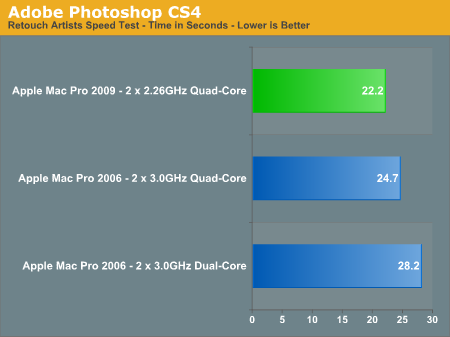
This test isn't heavily threaded from start to finish, some actions only stress one or two cores while others will drive all sixteen virtual threads on the new Mac Pro. The speedup from Hyper Threading is enough however to give the new Mac Pro an advantage, even at a lower clock speed, over the older model. This makes sense given how well the Nehalem based Core i7s do in our CS4 benchmark in Bench.
Apple Aperture 2.1.2 Performance
While Photoshop lets us do a lot of photo processing, Aperture is useful in managing workflow before we get to the heavy processing stages of Photoshop. For this test I'm exporting one of the sample albums that comes with Aperture from RAW to JPEG format.

The results here aren't uncommon. In a lightly threaded task you shouldn't expect the new Mac Pro to be faster than the old one, there's no replacement for clock speed. Other workloads will be hurt simply because L2 cache sizes are smaller with Nehalem then they were previously (only 256KB L2 per core with Nehalem).
Xcode Performance
Good compiler tests are hard to come by, but I've found that building the Adium source in Xcode is not only repeatable but a great test of platform performance. The build process is multithreaded and will use up to 16 threads, although not consistently over the course of the build.

Hyper Threading has the potential to really help the new Mac Pro if you're running a heavily threaded workload. The Xcode test is the perfect example of a real world usage scenario that doesn't max out all cores, but still does very well on the new Mac Pro.
Adobe Premier Pro CS4 Performance
Video encoding under Quicktime was a bust, but using a professional encoder like Premier Pro shows the strength of Nehalem:
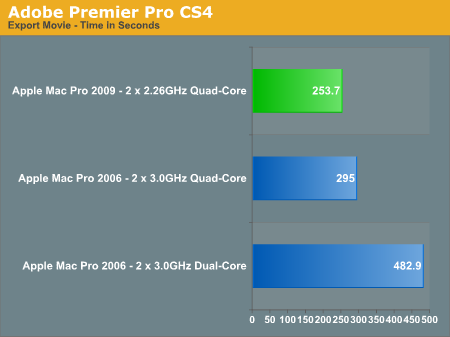
At 2.26GHz we're faster than eight cores running at 3.0GHz with the first Mac Pro. Throw in a pair of 2.93GHz Xeons and you'll see another ~20% performance improvement on top of that.
I would guesstimate that the quad-core 2.66GHz Mac Pro should deliver performance similar to (if not slightly slower than) the older 8-core 3.0GHz Mac Pro.
Quicktime H.264 Encoding Performance
While video encoding can definitely benefit from the monster threading abilities of the new Mac Pro, lighter encoding workloads don't really benefit:
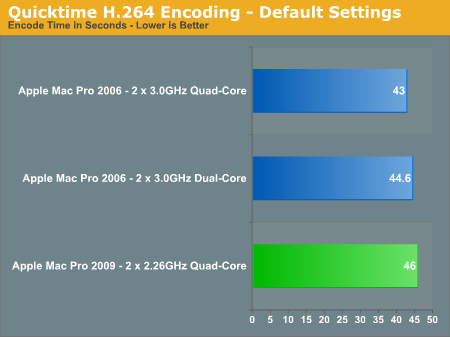
Quicktime is hardly the best application to do serious video encoding, here we see it barely scales beyond two cores - Nehalem has nothing to offer us in this sort of a situation.
iWork, iLife and General Use Performance
If you plan on using your Mac Pro for more than just rendering, encoding and computation, you'll find that it does work very well as a general use machine:

But clock speed definitely matters. In these two iWork benchmarks the 2.26GHz eight-core Mac Pro is measurably slower than its 3GHz predecessors. You'll at least need the 2.93GHz upgrade to equal their performance here.
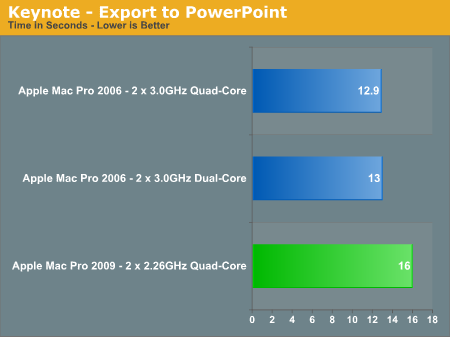
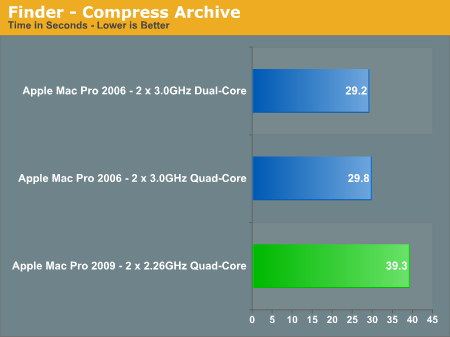
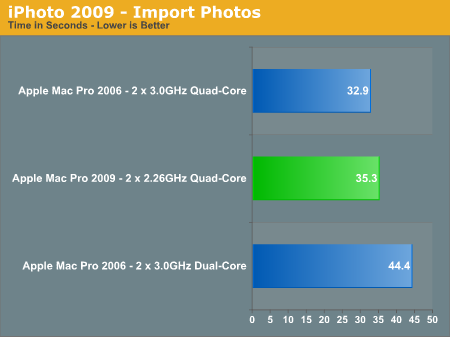










58 Comments
View All Comments
analog1 - Thursday, July 16, 2009 - link
Why not run the same benchmarks, like Premier pro cs 4 and Photoshop on a Core i7 PC?I think the results will surprise a low of people. I have sen comparisons done with Protools - a highly threaded proffessional DAW ( Digital Audio Workstation) 8 core nehalem Mac Pro (16 thread) vs an OCed i7 920 (3.6 ghz) and the 920 beat the mac pro by roughly 20%. This is probably due to much higher clock speeds, much higher memmory speeds and bandwidth, and much more efficient OS! (yes Windows XP). All this for about $2000 less.
If display cards had anything to do with this test the price/performance difference would be even higher. This is testing audio processing only.
I think if Anand could take the time and bench an OCed or stock i7 920 vs 8 core mac pro on the apps used with the same content we will all be finally able to throw the mac 'CREATIVITY' marketing slogan out the window for good.
I use macs every other day and am writing this on a mac (dual G5, but still). I also use PCs on a daily basis. all for work no play. I have been doing this for years, and honestly I don't understand why people like macs. they are SIMPLER not BETTER.
OSX has nice animation, and the iPhone is cool. Bravo Apple. Now can we please get a REAL bench for these apps PC vs Mac so we can all go to sleep knowing we actually do have the best system for $1000, even if it was designed by Antec+Seasonic+Corsair+Termalright+Gigabyte and so on... (and not buy Apple)
tstm - Wednesday, July 15, 2009 - link
What this article deserves, is a slap to Apple because of their memory configurations.The low end Mac Pro comes with four (4) memory slots. That's utterly ridiculous, considering that Nehalem supports triple channel memory. Adding 8GB (4x2GB) of memory will bring the memory bandwidth down somewhat, which is unacceptable for a $2500 machine.
The 8 core version, on the other hand, comes with 8 slots, again not a multiple of 3. With DDR3 SDRAM 4GB sticks being so ridiculously expensive, this makes any larger memory configs for the Mac Pro extremely expensive.
There's one more gripe: The server CPUs Apple uses could use RDIMM or UDIMM memory, which is _a LOT_ cheaper than normal DDR3 SDRAM mostly because it's being used in server configurations where it's not unheard of to have 192GB of ram in a machine, no one wants to pay gazillions for the 8GB DDR3 SDRAM sticks that would require.
Buying a server board with 18 RDIMM/UDIMM memory slots for building a similar workstation as the Mac Pro would be an insanely much better solution for anything that requires memory to operate (running multiple test VMs for instance). I think it's pretty sad that apple is not even trying to cater professionals with this "Mac Pro" toy they've built. I really would like to use an apple computer, but these drawbacks made me use a Hackintosh, which has its own drawbacks.. but for workstation use none are so bad when you compare it to the Mac Pro.
fmaste - Tuesday, July 14, 2009 - link
So, this is a good computer after changing the CPU and buying a second video card. How could someone say that this is OK? I don't think that Apple notebooks are expensive, you really get a premium notebook with all premium components, but this seems very overpriced.I like Apple and OSX a lot, but the case and interior design don't cost that much, you can build your own computer for much less, and with one of the awesome cases reviewed here at anandtech.
Also, what about GPU performance and comparison?
Third party GPUs? How? Expansion slot available?
Power, Noise, heat?
What about Boot Camp?
Type of memory?
And I would really appreciate a price and performance comparison with other workstations and what you can build for that money.
Tutor - Thursday, July 16, 2009 - link
This is my dream machine at post #10. I call it MyHackedUpMac.Tutor - Thursday, July 16, 2009 - link
http://forums.macrumors.com/showthread.php?t=71393...">http://forums.macrumors.com/showthread.php?t=71393...BoboGO - Tuesday, July 14, 2009 - link
Two 3.2GHz Quad-Core Intel Xeon "Nehalem" processors!12GB (6 x 2GB) DDR3 1333 (PC3 10600) memory
NVIDIA GeForce GTX 285 with 2GB GDDR3 memory
8X Blu-Ray Writer
250GB Vertex SATA II MLC Internal Solid state disk (SSD)
1TB SATA 3.0Gb/s hard drive
22X DVD/CD double-layer writer with LightScribe support
X-Fi Titanium Fatal1ty Champion Series 7.1 Channels PCI-Express Sound Card
Thermaltake Xaser VI Black Aluminum Computer Case
Sorry, no monitor included.
Ships: 3 days
Total Cost: $5833.00
vailr - Tuesday, July 14, 2009 - link
Re:"I couldn’t wait any longer and I ended up building a Hackintosh based on Intel’s Core i7. Literally a day after I got it up and running, Apple announced the new Nehalem-EP based Mac Pro."
More details, please.
List of parts used & cost, the method used for installing OSX, & a "bang for buck" comparison with Apple's equivalent machine.
TIA
erple2 - Wednesday, July 15, 2009 - link
That's a good question. Also, how much time did you spend getting the Hackintosh up and running?And for the final question, how much do you believe your time to be worth? I know how much I am paid per hour at my job. It doesn't take that long of hassling with a Hackintosh to make it worth my while to just buy the Mac instead. Include time spent when I go to update the OS and have to research which updates will work with my particular Hackintosh, plus those times that I accidentally do an update that I didn't fully research and hosed my setup. Oh, and make sure that I factor in some time for when my soundcard just didn't quite work right after a reboot...
Ultimately, it boils down to the triplet: Time, Money, Productivity - pick two.
Baked - Tuesday, July 14, 2009 - link
Wait, people actually upgrade their Mac? I thought they just buy a new one when it gets real slow. At least that's what happens at the places I worked at. Buy a brand new Mac, use it for a few years, buy a new one and send the old one to surplus. We do buy memory from micron instead of doing it through Apple though.xz4gb8 - Tuesday, July 14, 2009 - link
You said, "Between the high cost of the adapter and the high likelihood of problems, I’d suggest simply getting another video card if you want to have multiple 30” displays connected to your Mac Pro. Apple sells the GeForce GT 120 for $150 as an upgrade option, and at least with it each 30” display will be driven by its own frame buffer, which should make for smoother Exposé and Dashboard operation."If you allow non-Apple displays, many higher-end displays have DisplayPort connectors - see the Dell 3008WFP, for example. A mini-DP to DP cable is under $20 including shipping.
The mini-DP to DVI adapter is too clunky and tends to unplug itself. The mini-DP to HDMI adapter is under $20 and is slightly less clunky. Neither are as elegant as the mini-DP to DP cable.
I make no claims for the Video card performance.